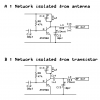Willen
Well-Known Member
Here are 200mW, 1 watt and 5 watt different RF amps. Each has input and output impedance matching network. Hope these amps are good.
But if I connected these different amps together, may be it is not need to use these network between amps. Because 1st input matching network converts 4K ohms impedance (from oscillator or class A amp) into 10 ohms for Class C input. And at the collector of Class C, there is no impedance change. So I think there is no necessary to use another input matching for next Class C (it is already converted 10 ohm at first). So I used single coupling capacitor- Trimmer and a small inductor.
Only at last I used Output matching network for 50 ohms antenna which converts 10 ohms into 50 ohms. I don't have more idea about such matching network. Am I doing good?
But if I connected these different amps together, may be it is not need to use these network between amps. Because 1st input matching network converts 4K ohms impedance (from oscillator or class A amp) into 10 ohms for Class C input. And at the collector of Class C, there is no impedance change. So I think there is no necessary to use another input matching for next Class C (it is already converted 10 ohm at first). So I used single coupling capacitor- Trimmer and a small inductor.
Only at last I used Output matching network for 50 ohms antenna which converts 10 ohms into 50 ohms. I don't have more idea about such matching network. Am I doing good?
Attachments
Last edited:





